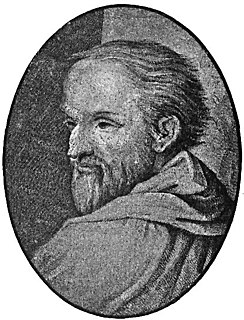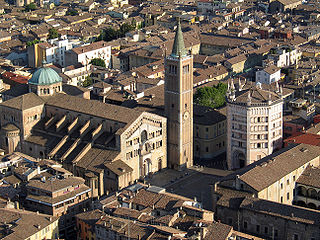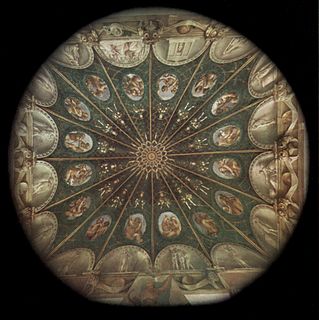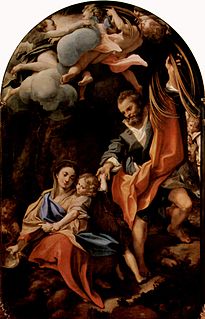
Antonio Allegri da Correggio, usually known as just Correggio, was the foremost painter of the Parma school of the High Italian Renaissance, who was responsible for some of the most vigorous and sensuous works of the sixteenth century. In his use of dynamic composition, illusionistic perspective and dramatic foreshortening, Correggio prefigured the Baroque art of the seventeenth century and the Rococo art of the eighteenth century. He is considered a master of chiaroscuro.

Giovanni di Niccolò de Luteri, better known as Dosso Dossi, was an Italian Renaissance painter who belonged to the School of Ferrara, painting in a style mainly influenced by Venetian painting, in particular Giorgione and early Titian.

Girolamo Francesco Maria Mazzola, also known as Francesco Mazzola or, more commonly, as Parmigianino, was an Italian Mannerist painter and printmaker active in Florence, Rome, Bologna, and his native city of Parma. His work is characterized by a "refined sensuality" and often elongation of forms and includes Vision of Saint Jerome (1527) and the iconic if somewhat anomalous Madonna with the Long Neck (1534), and he remains the best known artist of the first generation whose whole careers fall into the Mannerist period.

Illusionistic ceiling painting, which includes the techniques of perspective di sotto in sù and quadratura, is the tradition in Renaissance, Baroque and Rococo art in which trompe-l'œil, perspective tools such as foreshortening, and other spatial effects are used to create the illusion of three-dimensional space on an otherwise two-dimensional or mostly flat ceiling surface above the viewer. It is frequently used to create the illusion of an open sky, such as with the oculus in Andrea Mantegna's Camera degli Sposi, or the illusion of an architectural space such as the cupola, one of Andrea Pozzo's frescoes in Sant'Ignazio, Rome. Illusionistic ceiling painting belongs to the general class of illusionism in art, designed to create accurate representations of reality.

Giovanni Maria Francesco Rondani was an Italian painter, active in a Renaissance style in Parma.

Parma Cathedral is a Roman Catholic cathedral in Parma, Emilia-Romagna (Italy), dedicated to the Assumption of the Blessed Virgin Mary. It is the episcopal seat of the Diocese of Parma. It is an important Italian Romanesque cathedral: the dome, in particular, is decorated by a highly influential illusionistic fresco by Renaissance painter Antonio da Correggio.

The Assumption of the Virgin is a fresco by the Italian Late Renaissance artist Antonio da Correggio decorating the dome of the Cathedral of Parma, Italy. Correggio signed the contract for the painting on November 3, 1522. It was finished in 1530.

The Rest on the Flight to Egypt with Saint Francis is a painting by the Italian Renaissance master Correggio, dated to c. 1520 and now in the Uffizi Gallery of Florence. The Rest on the Flight into Egypt was a popular subject in art.

Adoration of the Christ Child is an oil on canvas painting by the Italian Renaissance artist Correggio, dating from around 1526 and housed in the Uffizi Gallery of Florence, Italy.

San Giovanni Evangelista is a church in Parma, northern Italy, part of a complex also including a Benedictine convent and grocery.

The Galleria nazionale di Parma is an art gallery in Parma, northern Italy.

The Montini Altarpiece is an oil on canvas painting by the Italian Renaissance artist Cima da Conegliano, dating from around 1506-1507 and housed in the Galleria Nazionale of Parma, Italy.

The Madonna and Child with Sts Jerome and Mary Magdalen is an oil on canvas painting by the Italian Renaissance artist Correggio dating from around 1528 and housed in the Galleria Nazionale of Parma, Italy.

The Camera di San Paolo or Camera della Badessa is a room in the former Monastery of San Paolo, in Parma, northern Italy. It is painted with frescoes by Correggio in the vault (697x645 cm) and over the fireplace.

Madonna della Scodella is an oil painting on panel by Antonio da Correggio, dated from 1528 to about 1530 and preserved at the Galleria nazionale di Parma.

Saints Roch, Anthony Abbot and Lucy or Three Saints is a 1513 oil on canvas painting by Cima da Conegliano, which is now in the collection of the Metropolitan Museum of Art in New York.

The Madonna and Child with the Infant John the Baptist is a 1513–1514 painting by the Italian artist Correggio.

The Lamentation of Christ is an oil on canvas painting by the Italian Renaissance artist Correggio, dating from around 1524 and housed in the Galleria Nazionale of Parma, Italy.

Mystic Marriage of Saint Catherine or Mystic Betrothal of Saint Catherine is a c.1524 oil on canvas painting by the Italian Renaissance painter Parmigianino. The work is now in the Galleria nazionale di Parma. Art historians argue that the work may be attributed to the period in which Parmigianino was painting his first works in the church of San Giovanni Evangelista, as also emerges from a recent restoration, which has shown that its technique is near-identical to that of Parmigianino - "no underdrawing, pigment use, descriptive speed, drafting of final shadows, using fingers and brush-ends as tools".

Madonna and Child with Saints is a 1586 oil on canvas painting by Agostino Carracci, dated on the lowest step of the Virgin Mary's throne. An example of a sacra conversazione. Long in the Benedictine abbey of San Paolo in Parma, French troops took it to Paris in 1796 and on its return to Italy in 1816 it was moved to the Galleria nazionale di Parma, where it still hangs.




















